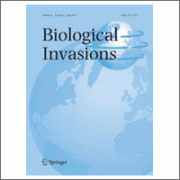Secondary Invasion of the Round Goby Into High Diversity Great Lakes Tributaries and Species at Risk Hotspots: Potential New Concerns for Endangered Freshwater Species
AUTHOR(S): Mark Poos, Alan J. Dextrase, Astrid N. Schwalb, Josef D. Ackerman
CITATION:
Poos, M., A.J. Dextrase, A.N. Schwalb and J.D. Ackerman. 2010. Secondary invasion of the Round Goby into high diversity Great Lakes tributaries and species at risk hotspots: Potential new concerns for endangered freshwater species. Biol. Invasions. (2010) 12(5):1269-1284. http://dx.doi.org/10.1007/s10530-009-9545-x
ABSTRACT:
The Round Goby (Neogobius melanostomus) first invaded North America in 1990 when it was discovered in the St. Clair River. Despite more than 15 years of potential invasion, many Great Lakes’ lotic systems remained uninvaded. Recently, we captured the Round Goby from several Great Lakes tributaries known as species-at-risk hotspots.
With a combination of field sampling of Round Gobies and literature review of the impact of Round Gobies on native taxa, we assess the potential impacts of the secondary invasion to native species using three mechanisms: competition; predation; and indirect impacts from the loss of obligate mussel hosts. We estimate that 89% (17/19) of benthic fishes and 17% (6/36) of mussels that occur in these systems are either known or suspected to be impacted by the secondary invasion of Round Goby. In particular, we note that the distribution of potential impacts of Round Goby invasion was largely associated with species with a conservation designation, including seven endangered species (1 fish, 6 mussels). As these recent captures of Round Goby represent novel occurrences in high diversity watersheds, understanding the potential impacts of secondary invasion to native biota is fundamental to prevent species declines and to allow early mitigation
FULL TEXT – Poos et al.



